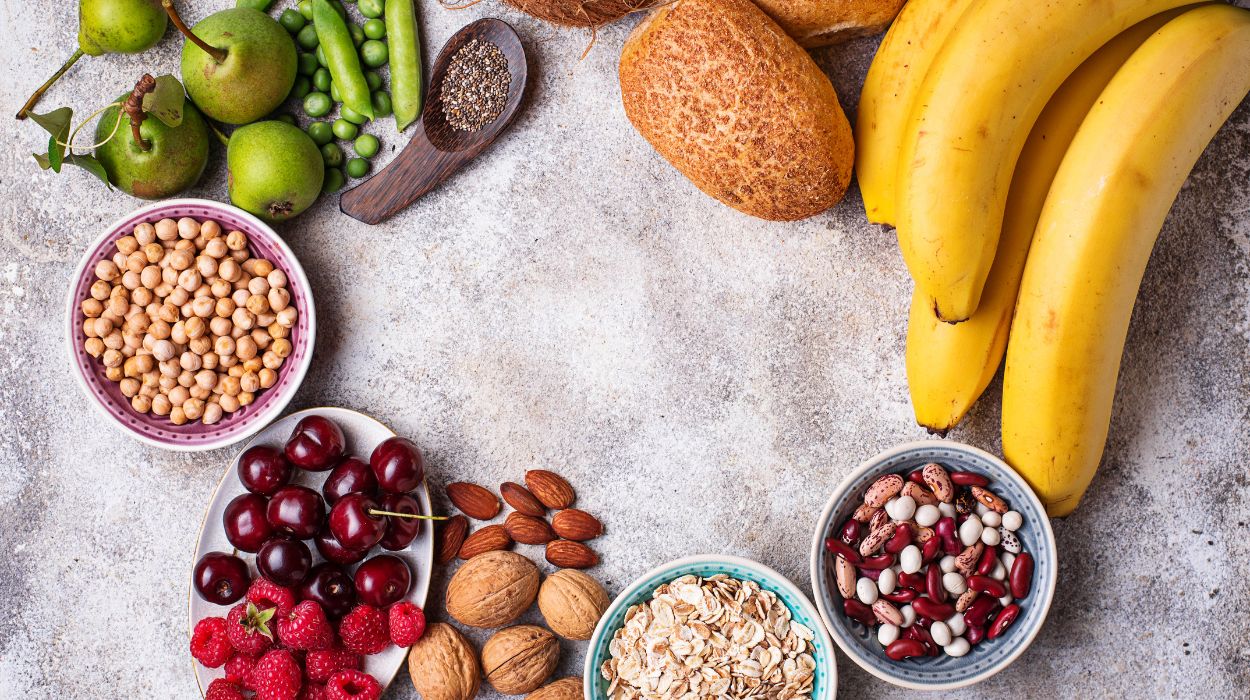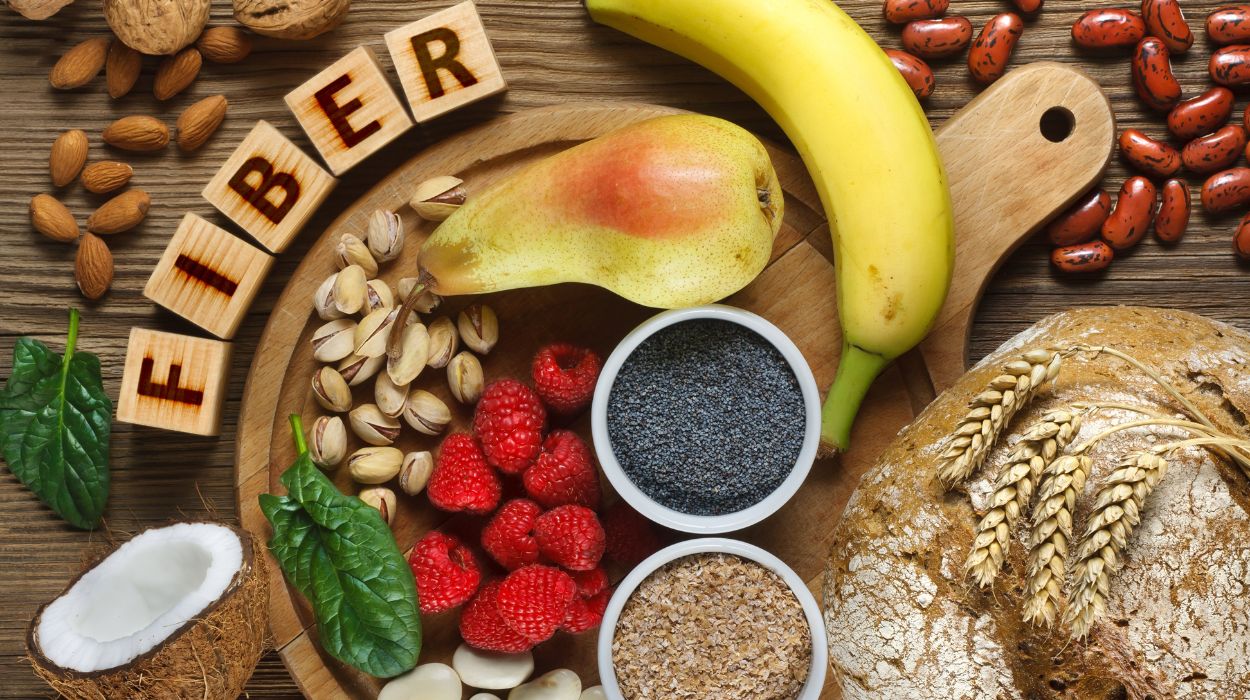We’ve all heard about the health benefits[1] of dietary fiber, but did you know that fiber plays a key role in weight loss too? Whether you’re aiming to shed some pounds or just looking to improve your overall health, understanding how much fiber per day to lose weight can make a world of difference.
We explore the magic number for daily fiber intake, delve into the types of fiber (yes, there’s more than one), and even point you in the direction of a how much fiber per day to lose weight calculator[2] and other tools.
How Much Fiber Should I Eat To Lose Weight?
For most individuals aiming to lose weight, the target is 23-38 grams of fiber per day. Factors that impact your fiber needs include age, gender, activity level, and overall health goals. It’s important to consume both soluble and insoluble fiber from a variety of sources, including fruit, vegetables, legumes, nuts, and seeds. Understand your baseline dietary needs, read food labels, adjust your diet slowly, and reevaluate on a regular basis.
How Much Fiber Per Day To Lose Weight
Losing weight can turn into a complex endeavor with many questions. A nutritional calculator[3] can help you set targets for carbs and other macronutrients. Today, let’s focus on the unique properties of dietary fiber and the question, “how much fiber should I eat to lose weight?”
The Magic Number
For most individuals aiming to lose weight, the target is 23-38 grams of fiber per day. This number comes from dietary guidelines and numerous studies[4] that have found a link between higher fiber intake and effective weight loss.
Factors Affecting Your Fiber Needs
However, this isn’t a one-size-fits-all situation. Your ideal fiber intake[5] can vary based on:
- Age: As we grow older, our digestive system changes, sometimes requiring more fiber.
- Gender: Men generally need more fiber due to larger calorie needs. However, how much fiber per day to lose weight for a woman can change with specific dietary requirements and sex-specific conditions (such as pregnancy).
- Activity Level: If you’re more active, you might burn through calories (and fiber) faster. Conversely, being sedentary can lead to constipation and other gastrointestinal issues. Increasing your steps per day is a simple way to ease these discomforts.
- Overall Health Goals: While some patients are focused on weight loss alone, others might be looking to also manage blood sugar or heart health.
Tips For Increasing Fiber Intake
- Start Slow: Gradually add fiber to your diet. Consuming too much fiber too quickly can lead to discomfort.
- Diversify Your Diet: Add a variety of high fiber foods to ensure you’re getting both soluble and insoluble fiber.
- Stay Hydrated: Drink water. It aids in digestion and helps fiber do its job effectively.
How Does Fiber Help You Lose Weight?

Insoluble Fiber
Insoluble fiber is the tough guy of the fiber world. Here’s how it helps to lose weight:
- Adds bulk to meals: This type of fiber isn’t digested by the body. Instead, it adds bulk to your food, making you feel fuller for longer from the same serving size.
- Supports digestive health: By speeding up the passage of food and waste through the gut, fiber aids in regular bowel movements. This can help you feel like you’ve lost weight overnight.
- Low in calories: Foods high in insoluble fiber, like dark leafy vegetables and wheat bran, are typically low in calories, supporting a weight loss diet.
Soluble Fiber
Soluble fiber might seem gentler but has a big impact. Here’s its magic:
- Forms a gel-like substance: In the stomach, soluble fiber turns into a gel, slowing down digestion. This gives you a prolonged feeling of fullness, helping you eat less.
- Stabilizes blood sugar: By slowing the absorption of sugar, it helps regulate blood sugar levels. Stable blood sugar levels can reduce unnecessary snacking.
- Lowers bad cholesterol: Aside from weight loss, soluble fiber can help lower LDL or bad cholesterol levels, reducing the risk of heart disease.
Both kinds of fiber can be partners in your weight loss journey,[6] and they help in different ways. To answer the question “how much fiber should I eat to lose weight?” you have to consider more than a simple numerical figure.
What Are High Fiber Foods?
If you’re on the hunt for fiber-rich foods to incorporate into your diet, you’re in luck. From succulent fruits to hearty grains,[7] let’s explore the cornucopia of options available.
Fruit
- Apples: A medium apple offers around 4 grams of fiber with the skin on.
- Avocado: Beyond its healthy fats, it’s a great source of fiber.
- Bananas: Besides being potassium powerhouses, they provide about 3 grams of fiber.
- Berries: Strawberries, raspberries, blackberries, blueberries, and other fresh berries are delightful and fiber-rich.
- Kiwi: Small in size but offers a decent 2 grams of fiber per fruit.
- Oranges: Citrusy and sweet, they come with roughly 3-4 grams of fiber.
- Pears: A medium pear, skin and all, can serve up to 5 grams of fiber.
Vegetables
- Artichokes: Fresh or canned, they’re fun to build into recipes.
- Broccoli: An excellent fiber source, especially when steamed or stir-fried.
- Brussels Sprouts: These little greens can pack about 3 grams of fiber per cup.
- Carrots: Crunchy and sweet, they offer about 4 grams of fiber when consumed raw.
- Dark Leafy Vegetables: Spinach, kale, and collard greens are iron-rich and fiber-filled.
- Green Peas: Frozen or fresh, they’re a good fiber source.
- Sweet Potatoes: A medium one can yield about 3-4 grams of fiber.
Grains and Legumes
- Barley: Another excellent grain choice, especially in soups.
- Beans: Black beans, navy beans, and kidney beans are all high in fiber.
- Chickpeas: These legumes are delicious and fiber-dense and go down easy in the form of hummus.
- Edamame: Young soybeans, perfect for snacking or adding to dishes.
- Lentils: Fiber-rich and versatile, perfect for soups and stews.
- Quinoa: A gluten-free grain that serves up to 5 grams of fiber per cup.
- Other Whole Grains: Options like brown rice, oat bran, whole wheat bread, and whole wheat pasta are rich in fiber.
Nuts and Seeds
- Almonds: A handful provides healthy fats and a good amount of fiber.
- Chia Seeds: Roughly 10 grams of fiber in just two tablespoons.
- Flaxseeds: Ground or whole, a great addition to smoothies or cereals.
- Hazelnuts: A delightful treat with about 3 grams of fiber per serving.
- Pumpkin Seeds: Perfect for snacking or topping salads.
- Sunflower Seeds: Add them to your dishes for a fiber boost.
- Walnuts: Besides omega-3s, they’re a decent source of fiber.
Remember, diversifying your sources of fiber ensures you reap the most benefits. With these options in mind, you can easily tailor your diet to contain more high fiber food.
How To Determine How Much Fiber Intake You Need To Lose Weight

Determining whether or not you’re eating enough fiber can feel like a puzzle. But don’t worry, we’re here to help you piece it all together. Everyone’s body is unique, so it’s all about finding what works best for you.
Understand Dietary Guidelines
The recommended intake[8] for women is about 25 to 32 grams of fiber a day, while men should target around 30 to 35 grams. This number can vary based on factors like age and activity level.
Instead of obsessing over exact grams, focus on incorporating a variety of fiber-rich foods into your diet. This ensures a mix of both types of fiber in your daily diet.
Online tools[9] can calculate fiber intake as well as net carbs and other macronutrients.
Start Slowly
Start slow if you’re not used to a high-fiber diet. Suddenly increasing your fiber intake can lead to digestive discomfort.
As you eat more fiber, drink plenty of water to keep your bowels moving. This aids digestion and prevents constipation.
Pay attention to how your body responds. If you feel bloated or experience discomfort, you might be adding too much too quickly.
Read Food Labels
Look for the total dietary fiber amount per serving. This helps you understand if a product truly fits into a high-fiber diet. Soluble and insoluble fiber are both important, so remember the benefits of both and aim for a balanced intake. Some labels break down fiber types, but not all fiber on labels is beneficial. Some processed foods have fillers or synthetic fiber, which might not offer the same health benefits as natural fiber.
Adjust Based on Goals and Feedback
If your main objective is to drop some weight, aim towards the higher end of the recommended intake. Eating fiber helps you feel full and eat fewer calories throughout the day, but it can still take time to lose weight. Adjust your fiber intake based on how your digestive system reacts. Feeling good? You’re on the right track.
If you experience discomfort, consider adjusting your intake or talking to a nutritionist or dietitian. They can provide insights based on your specific needs, such as how much fiber per day to lose weight for a woman. With this knowledge, you can now confidently navigate your nutrition journey. Your body will thank you, and so will your scale!
Conclusion
Fiber is necessary for good digestive health and successful weight loss. Understand the differences in soluble and insoluble fiber. Incorporate a mix of both into your diet, to leverage the satiating effects, regulate your blood sugar, and achieve weight loss goals efficiently. Don’t forget, it’s not just about the numbers but the quality and diversity of high-fiber foods you choose!
Your weight loss journey is about more than just cutting extra calories. You need to clean up your diet and stay hydrated. Drinking plenty of fluids can lower the risk of weight-related conditions such as high blood pressure, high cholesterol, and diabetes.
So the next time you find yourself pondering about how to lose arm fat in 2 weeks or losing weight without exercise, remember the subtle power of fiber in your dietary arsenal. Jazz up your breakfast with chia seeds. Bulk up your stir-fry with plenty of vegetables. Adding fiber to your diet helps fuel your body with the goodness it craves.
Frequently Asked Questions
Yes, dietary fiber can aid in reducing belly fat by promoting feelings of fullness and regulating blood sugar.
Regular fiber intake can support weight loss, but it should be combined with a balanced diet and physical activity.
Soluble fiber, found in oats, beans, and some fruits, can be especially effective at helping people lose weight.
Yes, fiber can help maintain a healthy metabolism by supporting healthy bacteria in the gut.
Whole grain rice, especially brown rice, contains more fiber than white rice. However, there are other grains with higher fiber content.
 Expert's opinion
Expert's opinion
